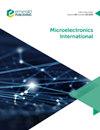不同热阻衬底增强ingaalp基小功率SMD led光通量
IF 0.7
4区 工程技术
Q4 ENGINEERING, ELECTRICAL & ELECTRONIC
引用次数: 0
摘要
目的:发光二极管(led)设计的优化及其长期可靠性与其光度、电学和热特性直接相关。对于给定的LED系统热布局,最大光通量发生在最佳的电输入功率,可以使用光电热学(PET)理论确定。本研究的目的是将PET理论中的光通量方程扩展到低功率(LP) led。设计/方法/方法lp表面安装器件led安装在不同热阻的基板上。三个led连接在阻燃玻璃纤维环氧树脂(FR4)基片和两个导热系数约为1.0 W/m的铝基金属芯印刷电路板(mcpcb)上。K, 2.0 W/m。K和5.0 W/m。分别K。采用热瞬态测试仪与led系统的热辐射特性相结合的方法,在一定的输入电流和温度范围内测量led的热光学参数。结果光通量方程推广应用的正确性得到了验证,实际计算结果与理论计算结果吻合较好。结果表明,FR4和两种mcpcb上的led的最佳光通量分别为25.51、31.91和37.01 lm。因此,LED数据表中规定的最大电输入功率(0.185 W)在三种基板之间转移到0.6284,0.6963和0.8838 W。原创性/价值在相同的系统功率下,使用大量低功耗led比高功率(HP) led更可取,以增加传热并提供更高的光通量。PET理论方程已应用于使用各种热阻散热器的HP led。本文将PET理论光通量方程推广到不同热阻衬底上的磷化铟镓铝LP led。本文章由计算机程序翻译,如有差异,请以英文原文为准。
Enhancement of luminous flux of InGaAlP-based low-power SMD LEDs using substrates with different thermal resistances
Purpose
Optimization of light-emitting diodes’ (LEDs’) design together with long-term reliability is directly correlated with their photometric, electric and thermal characteristics. For a given thermal layout of the LED system, the maximum luminous flux occurs at an optimal electrical input power and can be determined using a photo-electro-thermal (PET) theory. The purpose of this study is to extend the application of the luminous flux equation in PET theory for low-power (LP) LEDs.
Design/methodology/approach
LP surface-mounted device LEDs were mounted on substrates of different thermal resistances. Three LEDs were attached to substrates which were flame-retardant fiberglass epoxy (FR4) and two aluminum-based metal core printed circuit boards (MCPCBs) with thermal conductivities of about 1.0 W/m.K, 2.0 W/m.K and 5.0 W/m.K, respectively. The conjunction of thermal transient tester and thermal and radiometric characterization of LEDs system was used to measure the thermal and optical parameters of the LEDs at a certain range of input current and temperature.
Findings
The validation of the extended application of the luminous flux equation was confirmed via a good agreement between the practical and theoretical results. The outcomes show that the optimum luminous flux is 25.51, 31.91 and 37.01 lm for the LEDs on the FR4 and the two MCPCBs, respectively. Accordingly, the stipulated maximum electrical input power in the LED datasheet (0.185 W) is shifted to 0.6284, 0.6963 and 0.8838 W between the three substrates.
Originality/value
Using a large number of LP LEDs is preferred than high-power (HP) LEDs for the same system power to augment the heat transfer and provide a higher luminous flux. The PET theory equations have been applied to HP LEDs using heatsinks with various thermal resistances. In this work, the PET theory luminous flux equation was extended to be used for Indium Gallium Aluminum Phosphide LP LEDs attached to the substrates with dissimilar thermal resistances.
求助全文
通过发布文献求助,成功后即可免费获取论文全文。
去求助
来源期刊

Microelectronics International
工程技术-材料科学:综合
CiteScore
1.90
自引率
9.10%
发文量
28
审稿时长
>12 weeks
期刊介绍:
Microelectronics International provides an authoritative, international and independent forum for the critical evaluation and dissemination of research and development, applications, processes and current practices relating to advanced packaging, micro-circuit engineering, interconnection, semiconductor technology and systems engineering. It represents a current, comprehensive and practical information tool. The Editor, Dr John Atkinson, welcomes contributions to the journal including technical papers, research papers, case studies and review papers for publication. Please view the Author Guidelines for further details.
Microelectronics International comprises a multi-disciplinary study of the key technologies and related issues associated with the design, manufacture, assembly and various applications of miniaturized electronic devices and advanced packages. Among the broad range of topics covered are:
• Advanced packaging
• Ceramics
• Chip attachment
• Chip on board (COB)
• Chip scale packaging
• Flexible substrates
• MEMS
• Micro-circuit technology
• Microelectronic materials
• Multichip modules (MCMs)
• Organic/polymer electronics
• Printed electronics
• Semiconductor technology
• Solid state sensors
• Thermal management
• Thick/thin film technology
• Wafer scale processing.
 求助内容:
求助内容: 应助结果提醒方式:
应助结果提醒方式:


